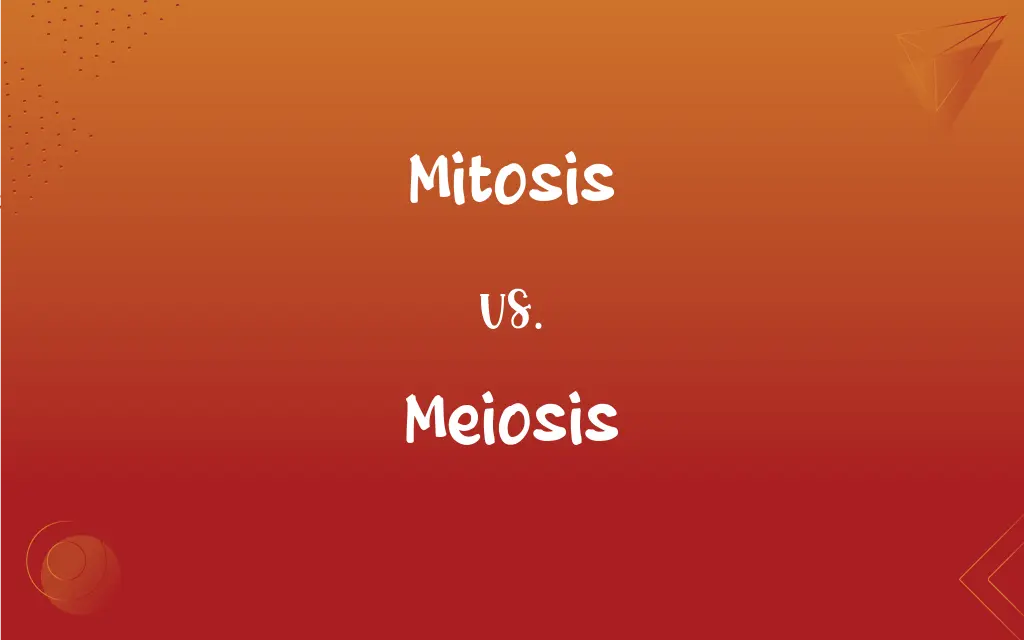Mitosis vs. Meiosis: What's the Difference?
Edited by Janet White || By Harlon Moss || Updated on October 30, 2023
Mitosis produces two genetically identical daughter cells, while meiosis results in four genetically varied gametes. Mitosis involves one division; meiosis undergoes two.

Key Differences
Mitosis and meiosis are fundamental processes in the realm of cell biology, driving growth, development, and reproduction. Mitosis pertains to the division of a cell's nucleus to generate two identical daughter cells, each having the same number of chromosomes as the parent. On the other hand, meiosis is a specialized form of cell division that creates four non-identical daughter cells, each with half the number of chromosomes of the original cell.
Mitosis plays an instrumental role in growth, repair, and general maintenance of an organism. When a cell undergoes mitosis, it duplicates its DNA, segregates the copies, and then divides, ensuring each daughter cell retains a full set of chromosomes. Meiosis produces gametes, which are sperm and egg cells in animals or pollen and ovules in plants, and these gametes contain half the typical number of chromosomes.
One notable aspect of mitosis is that it involves a single cell division, yielding two cells. These cells maintain the diploid chromosome number, which is characteristic of somatic cells in organisms. Meiosis is distinct as it encompasses two successive cell divisions—meiosis I and meiosis II. After these two rounds of division, four haploid cells emerge, each with a varied genetic composition.
Crossing over, a process where chromosome segments are exchanged, is a feature exclusive to meiosis, specifically during the prophase of meiosis I. This genetic recombination fosters genetic diversity within offspring. Mitosis, however, aims for genetic consistency, so no such exchange happens, and the daughter cells mirror the genetic content of their predecessor.
Comparison Chart
Number of Divisions
One division
Two divisions
ADVERTISEMENT
Resultant Cells
2 diploid daughter cells
4 haploid daughter cells
Genetic Composition
Genetically identical to parent
Genetically varied from parent
Crossing Over
Doesn't occur
Occurs during prophase I
Mitosis and Meiosis Definitions
Mitosis
Mitosis aids in growth and tissue repair.
When we grow taller, our bones elongate due to mitosis.
Meiosis
Meiosis reduces chromosome number by half.
A cell undergoing meiosis in humans will produce cells with 23 chromosomes, not 46.
ADVERTISEMENT
Mitosis
Mitosis involves a single round of nuclear division.
During mitosis, cells divide once to produce two identical cells.
Meiosis
Meiosis is a specialized cell division forming four genetically distinct cells.
Humans' sperm and egg cells result from meiosis.
Mitosis
Mitosis is a process of cell division resulting in two identical daughter cells.
The skin cells undergo mitosis to repair wounds.
Meiosis
Meiosis involves two sequential divisions.
Meiosis I is followed by meiosis II, each with distinct stages and outcomes.
Mitosis
Mitosis ensures genetic consistency across cells.
All cells of a multicellular organism, except gametes, are genetically consistent due to mitosis.
Meiosis
Meiosis introduces genetic variation via crossing over.
Genetic diversity in populations is heightened due to recombination events in meiosis.
Mitosis
Mitosis preserves the chromosome number of the parent cell.
After mitosis, each daughter cell has 46 chromosomes, just like in human somatic cells.
FAQs
What's the primary goal of mitosis?
Mitosis aims to produce two genetically identical daughter cells for growth and repair.
Do both mitosis and meiosis start with a single cell?
Yes, both processes initiate with one cell and result in multiple daughter cells.
Is the genetic content the same after mitosis?
Yes, after mitosis, daughter cells are genetically identical to the parent cell.
What's the significance of crossing over in meiosis?
Crossing over introduces genetic variation by exchanging DNA between homologous chromosomes.
How many chromosomes do human cells have after mitosis?
After mitosis, human cells retain the original 46 chromosomes.
Can mitosis produce gametes?
No, gametes are produced exclusively through meiosis.
Why don't organisms grow using meiosis?
Meiosis reduces chromosome numbers, making it unsuitable for growth which requires genetic consistency.
In what phase of meiosis does crossing over occur?
Crossing over happens during prophase I of meiosis.
How many divisions occur in meiosis?
Meiosis involves two divisions: meiosis I and meiosis II.
Is mitosis involved in repairing damaged tissues?
Yes, mitosis replaces damaged cells by creating genetically identical cells.
Why are the cells after meiosis genetically unique?
Genetic uniqueness arises from independent assortment and crossing over during meiosis.
In what cells does meiosis typically occur?
Meiosis occurs in germ cells to produce gametes like sperm and eggs.
How does meiosis contribute to genetic diversity?
Meiosis introduces variation through independent assortment and crossing over.
Are the cells after meiosis I diploid or haploid?
The cells post meiosis I are haploid, but with sister chromatids still attached.
Why is mitosis more common than meiosis in our body?
Mitosis maintains and repairs body tissues, while meiosis is specialized for reproduction.
How do mitosis and meiosis differ in chromosome alignment?
In mitosis, individual chromosomes align, while in meiosis, homologous chromosome pairs align.
What role do centromeres play in mitosis and meiosis?
Centromeres hold chromatids together, ensuring proper segregation during cell division.
Are mitosis and meiosis exclusive to animals?
No, both processes occur in animals and plants, with slight variations.
About Author
Written by
Harlon MossHarlon is a seasoned quality moderator and accomplished content writer for Difference Wiki. An alumnus of the prestigious University of California, he earned his degree in Computer Science. Leveraging his academic background, Harlon brings a meticulous and informed perspective to his work, ensuring content accuracy and excellence.
Edited by
Janet WhiteJanet White has been an esteemed writer and blogger for Difference Wiki. Holding a Master's degree in Science and Medical Journalism from the prestigious Boston University, she has consistently demonstrated her expertise and passion for her field. When she's not immersed in her work, Janet relishes her time exercising, delving into a good book, and cherishing moments with friends and family.































































